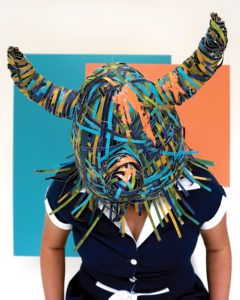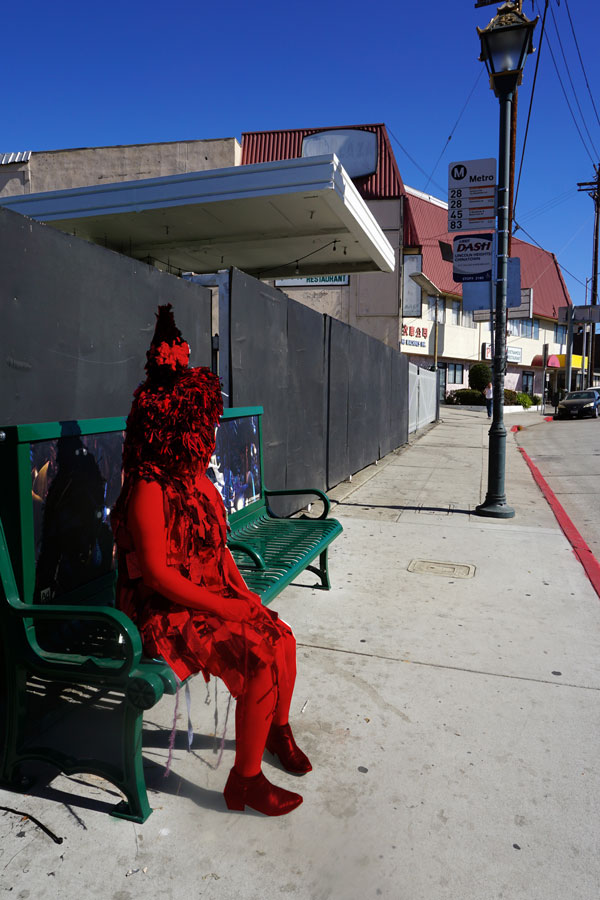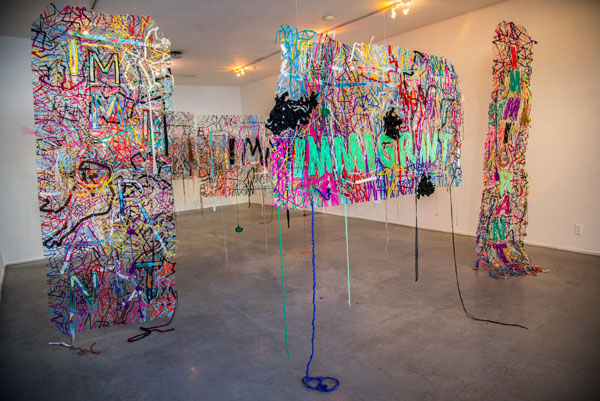Los Angeles artist Diane Williams engages such historical hierarchies as male/female, human/animal, and self/other in works that focus on her identity as a non-binary immigrant woman. Born in the Philippines in 1973, Williams (nee Diane Doreen Briones) came to this country as a young teen. She attended high school and college here, graduating from Cal State Long Beach in 2013. Since that time, she has participated in an impressive six one-person exhibitions and more than 50 group shows, as well as numerous performances and collaborations.
Williams is currently developing two bodies of work: “Monsters & Aliens,” a group of helmet-like animal masks used to explore racial and “gender ambiguity” (a phrase adopted from Simone de Beauvoir); and “My America,” a series of multi-media installation “modules” that address issues surrounding immigration. Suspended like large tapestries, the modules usually hang from ceilings.

Photo from performance, Monsters & Aliens.
Williams’ painted, drawn and photographed masks are exhibited alone or on mannequins. The artist also wears the masks in performances and in self-portrait photographs that are marked by a fractured, almost Cubist, disintegration. These objects completely obscure their wearer’s heads, like strange headgear from surreal realms. Williams’ human/animal combinations recall the female monsters of Ancient Greece: Medusa, the Harpies, the Sirens and Chimera. Their hybrid forms were considered both powerful and evil—much as today’s conservatives view outsiders, immigrants and, one might add, women in general.
Both the masks and installation modules are constructed from what the artist calls “cultural detritus”: ethnic fabric, yarn and plastic recycled from friends and family or salvaged from local shops that are traditionally owned, run and supported by immigrants. Strips of the materials are loosely woven, to achieve a lace-like fragility and transparency. Williams’ aesthetic responses to immigration and identity are formally “fluid” and mutable, reminding viewers of the multiplicities inherent in the postmodern de-centered self. Using her geographically bifurcated past, Williams interweaves multiple visions of gender and ethnicity to challenge cultural constructions of the unitary, fixed human subject. This is seen in the masks that allude to animals with large ears and snouts, but defy specific species labels.

Pleasantly Peculiar.
It is also seen in the tapestry-like modules that are limned by potent phrases across the woven fields of what many consider trash. What do words like “Immigrant” mean when split into “Im” and “Migrant”? What does “Migrant” mean when split into “Mi” and “Grant”? (“Mi” is of course Spanish for “my,” reminding viewers that the artist’s home country was conquered by Spain in the early 16th century—it was named after the Spanish Hapsburg monarch Phillip II—and Spanish is still widely spoken there.) “Fear,” “We” and “Alien”—words crucial to discourses on immigration issues—dominate other modules.
Throughout her oeuvre, Williams creates scattered “clues” to address the diasporic realities she engages. In this era dominated by the political demonization of women, immigrants and racial “minorities,” it is crucially important to consider the thoughtful responses to such issues articulated by savvy cultural workers like Diane Williams.


